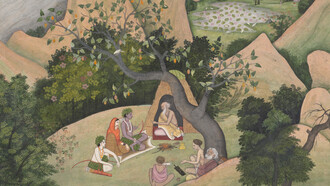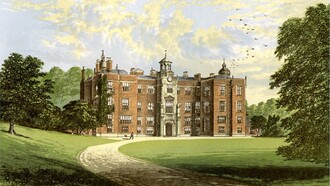Woven fabrics, embroidery lace, and the “Roman Jewish stitch” record the rich textile history of the old synagogues of the Roman Ghetto
Sarah, Rebecca, Rachel, and Leah--may He bless every daughter of Israel who fashions a coat or covering with which to adorn the Torah, or who prepares a candle in honor of the Torah, May the Holy One, blessed be He, pay her reward and grant her the good that she deserves, and let us say Amen.
According to the Chief Rabbi of Rome, the Italian rite contains a special additional blessing for “every daughter of Israel, who makes a me’il or mitpachat (mantle ) in honor of the Torah.” The me’il is the outer embroidered garment of the Torah scroll, the mitpachat is the inside wimple or handkerchief (in Modern Hebrew it means handkerchief). According to the Chief Rabbi of Rome, the Italian rite is one of a kind, and nowhere else will you hear blessings for women. The precious handmade and embroidered mappot fabrics represent direct Jewish participation, specifically female; the worthy women descendants of ancestors who, in the desert, had spun the fabrics for the tabernacle…”And all the skilled women spun with their own hands, and brought what they had spun, in blue, purple, and crimson yarns, and in fine linen.” (Exodus 35:25).
The Jews of Rome were forbidden from trading new fabrics, owing to Papal restrictions. The fabrics are embroidered from recycled material. Hence, the ritual nature is worth mentioning for clarity. The ritual question concerns whether or not this practice is actually allowed for the adornment for an object so sacred , such as the Sefer Torah (Torah Scroll), explains Rabbi Riccardo Di Segni, the Chief Rabbi of Rome. Rabbi Di Segni says that the rule is codified in the main books of religious law, such as the Shulchan A’rukh (Orach Chayim 153:21). It is also found in the addition of Moshe Isserles (147:1), where the practice is prohibited. In any case, the Roman Jews engage in this practice. “Our ancestors did it by virtue of necessity, bypassing papal bans and ritualistic principles that may be well founded, but definitely not absolute. in order to express their religious devotion and to honor the Torah.
Inside the former Ghetto, there was only one synagogue for the entire community, the building of the Cinque Scole, in which there were five rooms of worship, Scola Tempio for the Roman Jews. These partitions for worship included: Scola Nuova for the Jews of the Papal States, excluding Rome, Scola Castigliana and Scola Catalanafor for the Jews of the Iberian Peninsula. and Scola Siciliana for the Jews of southern Italy.
The Roman Ghetto was established in 1555 in the Sant’Angelo district, on the banks of the Tiber River in front of the Tiber Island. It was a neighborhood surrounded by walls and guarded by watchmen. The doors/gates were opened an hour after sunrise and were closed an hour before sunset.
Jews were prohibited to own real estate, jewelry, lavish clothing, and carriages. They were required to wear a distinctive symbol and forbidden to display any social status which did not pertain to their religious community. They were not permitted to acquire a certain affluence and were allowed to engage only in the profession of money lending, as well as dealing in junk and rags (stracciera seu cenceria).
It is interesting to note that the physical separation of the ghetto did not interrupt relations between Jews and Christians. Regardless, judging from frequent violations of the rules, the Jews of Rome moved freely around and outside the city, but were compelled to wear a special marking/ Likewise, Christians freely came to the neighborhood to do business and buy goods.
Inside the ghetto (enclosure). it has been noticed, extremely prosperous families lived side by side with extremely poor families. For example, there were about eight hundred families in the ghetto, and at least two hundred families were rich.
A recent study highlighted the telling detail that those Jews living on the inner most street of Via Rua, farthest from the Tiber River and its flooding, were comprised of the most affluent families. Social stratification already had existed in the Roman Jewish population even before the beginning of the Ghetto period.
With the arrival of the Spanish Jews from the Iberian Peninsula in 1492, a consistent and a more distinct social stratification began to emerge within the Jewish community of Rome. The most prominent were money lenders, craftsmen, small business workers. followed by the lowest class.
The Sephardic Jews were predominately bankers and economically dominated the old Roman and Italian groups. In fact, the wealthiest families were recognized and listed on mappot inscriptions, according to Attilio Milano, between 1682 and 1791/ Leone Ambron, Samuele Ascarelli, Yacob Baraffael, Angelo Castelnuovo, Shabat Del Monte, Michele Di Capua, and Tranquillo Volterra. These are families of non-Roman Jews, apart from those with names of Serena, or Sereni, who belonged to the Scola Tempio, the scola of the Jewish families. who lived in Rome before the arrival of the Spanish.
A guided visit with a museum educator and/or a licensed tour guide from the community explores these dedicatory embroidered inscriptions which are housed in our textile archive in Room One of the Museums. Not only does it verify the existence of the ancient Cinque Scole (during the time of the enclosure). It confirms, likewise, those of the Great Synagogue (from 1904 to 1942), explains Micaela Pavoncello of Jewish Roma. She explains how the true centers of Jewish life were the five beitery haknesset (le Cinque Scole, synagogues) of the ghetto (Catalana, Castigliana, Nuovo, Siciliana Tempio), which functioned as a house of prayer (three times a day), serving likewise as a space for education and meetings. Most importantly, it also “demonstrates how the Scole was the unifying bond of individual members of our Jewish community.”
Pope Paul IV’S papal bull Cum nimis absurdum inhibited the activities of the Jews of Rome by restricting trade activity to the resale of second-hand goods. This pope strictly forbade Jewish physicians to treat Christian patients, and he lowered the allowable interest rate for moneylenders.
The economic survival of the community rested on the uninterrupted circulation of used textiles and goods. It was the recycling of fabrics (textiles) that became a normal practice, including among the upper classes. It was in this context that the Roman Jews adapted themselves the best they could to abide to the special laws imposed to them by the Pope.
Serena Di Nepi, Strazzeria seu cenciara. The fabric market and the Jews of Rome, explains that the city market in Rome, for the Jews, was strongly linked to two entities: banking, which had not been prohibited to them, and trading in secondhand fabrics. These connections produced results of great interest. For instance, by the second half of the sixteenth century, companies of Jewish businessmen held important monopolies for managing fardelli—bundles of clothing once owned by the deceased from the principal Roman hospitals. Sepi goes on to say that the business involved the most important traders and creditors, who, with a strong reputation and recognized prestige, conducted negotiations with Christians, sharing the money (sum) with their coreligionists. Furthermore, this business model focused on the joint participation of small, medium, and larger ‘shareholders’, as well as on the diversification of investments, because it was the most important feature of life in the ghetto. It was this interface which provided opportunities for upward social mobility, making the fortunes and misfortunes of individuals and their families, thereby helping to define the structure of a highly stratified group, says Nepi.
The community’s museum preserves one of the most important collections of Jewish ceremonial textile artifacts in the world. The various mappot are the large wimples that wrap around the Pentateuch (Torah) scroll. They can be seen in the display cases and in the cabinet drawers arranged in the Textile Preservation room in the museum. Included in this marvelous collection are parochot, me’ilim, wimples, and tikkun tevah, all of which were donated over three centuries, from the end of the 1500s to the end of the 1800s, to synagogues, by families forced to live in the Roman Ghetto.
Most are ancient and originate from the Rome ghetto’s Five Synagogues building. Some appear in the display cases; others are inside the chest of drawers which has been designed to protect them from light. Many of the other textiles are still in use in the community’s synagogues.
One of the stops on a museum tour is the textile preservation center, located in room one. Other stops are inside the Great Synagogue and the Spanish Synagogue, where participants will learn about the Ambron Family’s oldest donation to the synagogues of the Rome Ghetto from the end of the sixteenth century to the end of the nineteenth century, on current display.















